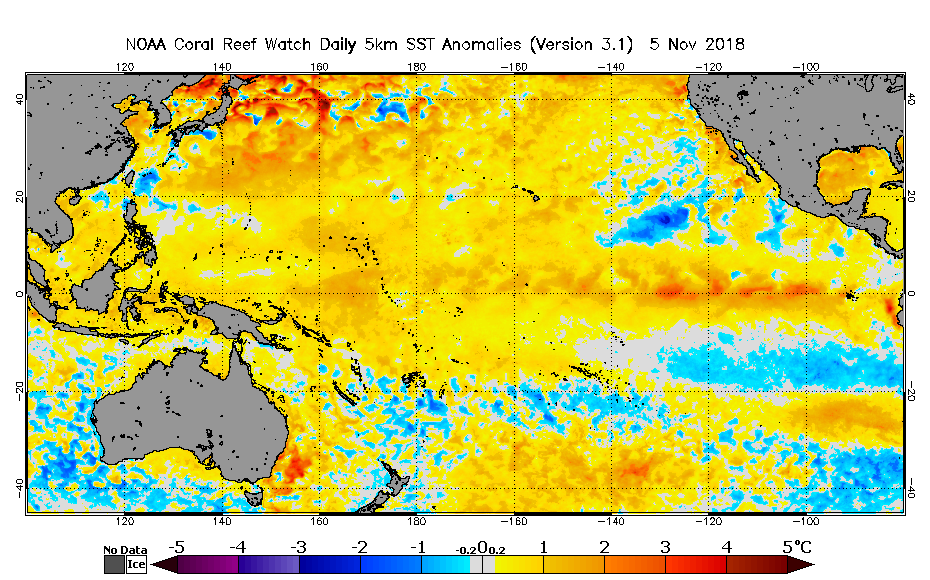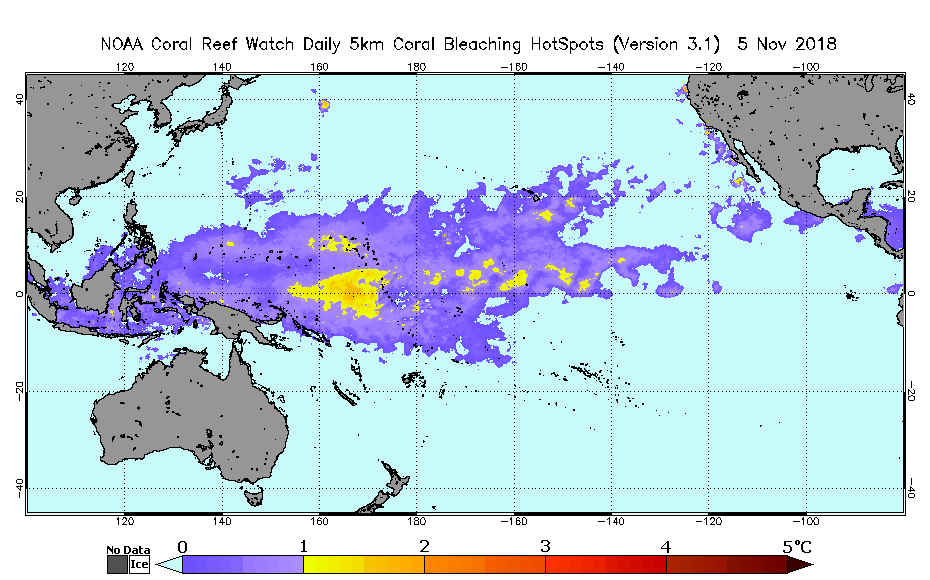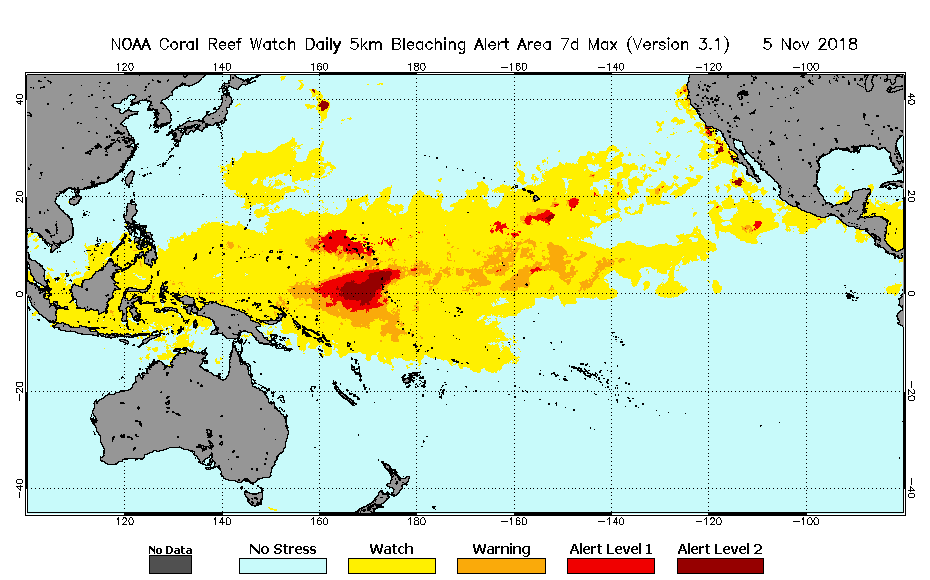Coral Bleaching Heat Stress Analysis and
Seasonal Guidance through February 2019
(Released November 6, 2018)
Current conditions:
NOAA Coral Reef Watch's (CRW) near real-time satellite monitoring shows above-average sea surface temperatures (SSTs) in much of the western tropical Pacific Ocean, with the highest anomalies (approaching, but not exceeding 2°C) surrounding the Marshall Islands, Nauru, and the Gilbert Islands, Kiribati (Figure 1). Additional warm anomalies in the Pacific Ocean have been present for the last month and are evident southeast of the Main Hawaiian Islands. In the central and eastern equatorial Pacific, Kelvin waves can be seen clearly propagating from the central equatorial Pacific near the Line Islands into the eastern Pacific. The spatial pattern of the SST anomaly has changed from bands of spatially alternating above- and below-average SSTs before October to persistently positive anomalies, indicating deepening of the thermocline consistent with a developing El Niño. El Niño Southern Oscillation (ENSO)-neutral conditions continued through September and October 2018. As of October 11, 2018, the NOAA National Centers for Environmental Prediction's ENSO Alert System predicts El Niño Watch status due to increasingly more widespread regions of above average SSTs across the equatorial Pacific Ocean. There is a 70-75% chance of an El Niño forming in the next few months and continuing through Northern Hemisphere winter 2018-19.

|
||
|
Figure 1. NOAA Coral Reef Watch's Satellite Sea Surface Temperature Anomaly product for the Pacific region. |
||
In recent months, HotSpots approached 2°C around the western Pacific island of Nauru and remained high for several weeks (Figure 2). Hotspots also crossed the 1°C threshold in the Marshall Islands and the Gilbert Islands, Kiribati. As a result, the current bleaching status for these three locations is at Alert Level 2 (Figure 3). The majority of the surrounding islands in the western Pacific Ocean remain at Bleaching Watch status, with the exception of Tuvalu which has increased to a Warning and the Northern Line Islands which has increased to Alert Level 1. Further heat stress is expected as El Niño conditions continue to develop.

|
||
|
Figure 2. NOAA Coral Reef Watch's Satellite Coral Bleaching HotSpot product for the Pacific region. |
||

|
||
|
Figure 3. NOAA Coral Reef Watch's Satellite Bleaching Alert Area (7-day maximum) product for the Pacific region. |
||
CRW's most recent Four-Month Coral Bleaching Outlook (Figure 4) projects continued severe heating (Alert Level 2) in the western Pacific around Nauru and the Gilbert Islands, Kiribati. By early December 2018, Tuvalu and surrounding islands are expected to reach Alert Level 1 with the possibility of Alert Level 2 by mid-January 2019. American Samoa and locations eastward to French Polynesia are expected to reach Bleaching Warning by January and Alert Level 1 by February 2019. The Solomon Islands also may reach Alert Level 2 during this time. Alert Level 2 conditions also are projected for the Northern Line Islands as early as mid-December. Continued heating will occur in the eastern equatorial Pacific Ocean surrounding the Galapagos Islands which are expected to reach Alert Level 2. The highest possibility of coral bleaching is expected in the western Pacific Ocean, with locations in the south central and eastern equatorial Pacific under threat in early 2019.

|
||
|
Figure 4. NOAA Coral Reef Watch's Four-Month Coral Bleaching Heat Stress Outlook of November 6, 2018 for the period November 2018-February 2019 for the Pacific region. |
||
***NOTE: This report incorporates NOAA Coral Reef Watch's Version 3.1 (or v3.1) 5km satellite-based coral bleaching heat stress products and v5 Four-Month Coral Bleaching Heat Stress Outlook.***
To monitor the intensity and location of bleaching heat stress in your coral reef region of interest, please follow NOAA Coral Reef Watch's satellite monitoring and outlooks closely in the coming weeks: https://coralreefwatch.noaa.gov/product/5km/index.php and https://coralreefwatch.noaa.gov/satellite/bleachingoutlook_cfs/outlook_cfs.php.
CRW's current satellite and modeled products can be found at:
https://coralreefwatch.noaa.gov/satellite/index.php
CRW's Four-Month Coral Bleaching Heat Stress Outlooks can be found at:
https://coralreefwatch.noaa.gov/satellite/bleachingoutlook_cfs/outlook_cfs.php
CRW's 5km satellite Regional Virtual Stations can be found at:
https://coralreefwatch.noaa.gov/vs/index.php
Sign up for automated bleaching alert emails for CRW's 5km Regional Virtual Stations at:
http://coralreefwatch-satops.noaa.gov/
CRW's 50km satellite Virtual Stations can be found at:
https://coralreefwatch.noaa.gov/satellite/vs.php
Please report bleaching events (or non-events) at:
https://coralreefwatch.noaa.gov/satellite/research/coral_bleaching_report.php
Disclaimer
The content posted on this web page solely represents the opinions of the authors and does not constitute a statement of policy, decision, or position on behalf of NOAA or the US Government.
The appearance of external links on this World Wide Web site does not constitute endorsement by the Department of Commerce/National Oceanic and Atmospheric Administration of external Web sites or the information, products or services contained therein. For other than authorized activities, the Department of Commerce/NOAA does not exercise any editorial control over the information you may find at these locations. These links are provided consistent with the stated purpose of this Department of Commerce/NOAA Web site.